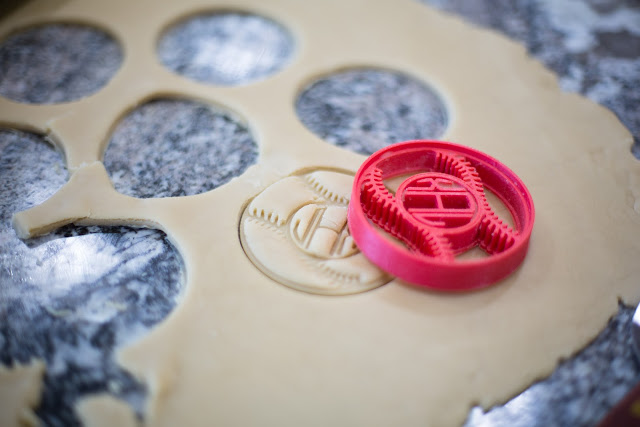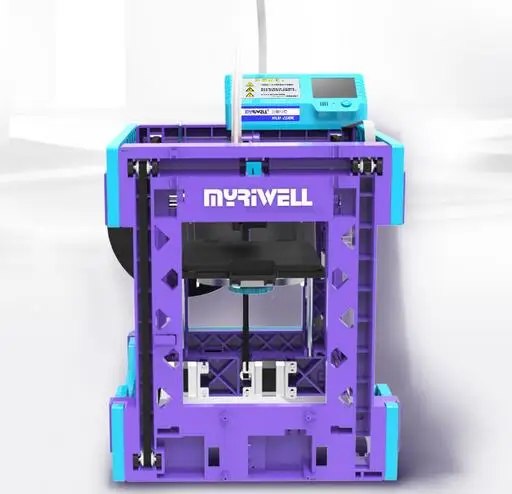3D printing resolution meaning
3 crucial things to know about 3D printing resolution
Resolution is often associated with televisions, camera lenses and smartphones. Even the human eye has resolution. Today, resolution is also used in 3D printing.
Resolution is one of the core features to consider especially when evaluating the quality of a 3D model. It is also important to know how 3D printing resolution affects the overall appearance and precision of the 3D printed parts.
To better understand 3d printing resolution, here is an informative blog post on 3 crucial things to know about 3D printing resolution. Read on here.
1. What is 3D printing resolutionSimply put, 3d printing resolution is a sign or indication on how accurate a 3D printer can print. It is also defined as the quality of the 3D printed part. It is described in 3 different dimensions. These are X, Y and Z dimensions.
- Horizontal resolution (XY) – this resolution is also called planar dimension.
It is the smallest movement that a 3D printer laser can make within a single layer. The smaller the movement of the laser, the better the details of the 3D model.
- Vertical resolution (Z) – it is the layer height or layer thickness. Smaller layer height means it has high resolution.
Resolution can be defined as the X-Y dimensions and layer thickness in micrometres (µm) or dots per inch. Micrometre is a unit that is used to describe the layer thickness of the 3D print. In 1 micron (µm - micrometre), there is 0.001mm or 0.000039 inches.
- Importance of 3D printing resolution
Setting up proper resolution on 3D printer will reflect the 3D model’s appearance, precision and printing time. Resolution should also be considered if the 3D model has highly detailed parts.
2. Factors that affect the 3D printed part resolutionListed below are some factors that affects the 3D printed part resolution.
- 3D printing technology choice
The temperature of the extruder/heated platform can affect the resolution of the 3D part.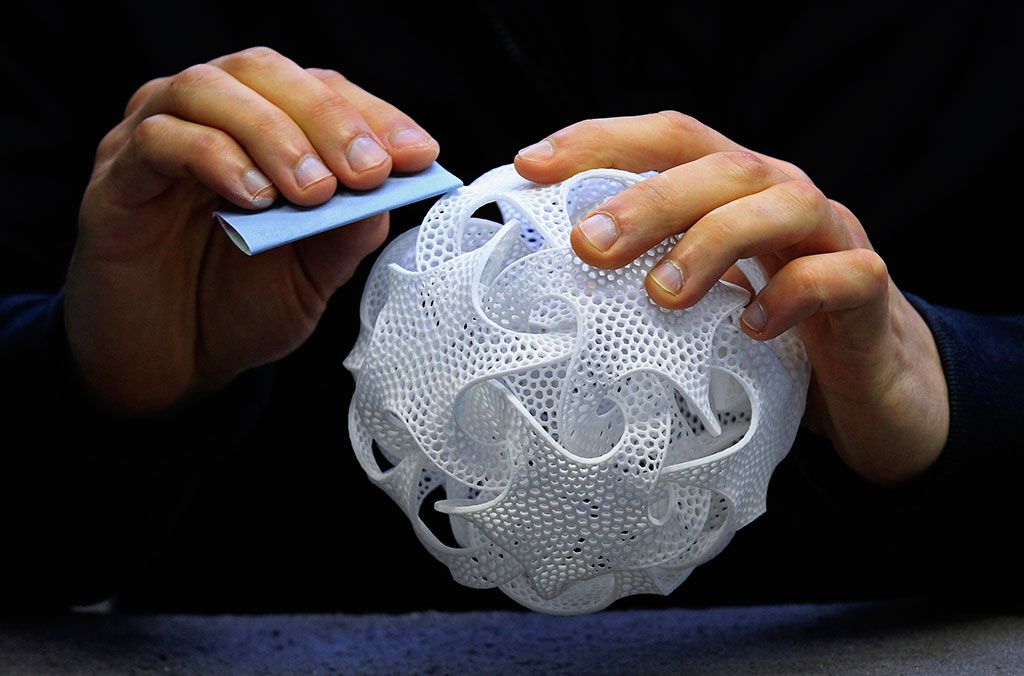 Thus, it is necessary to set the extrusion temperature depending on the 3D printing technology being used. Different 3D printing technologies may have different results when it comes to printing resolution.
Thus, it is necessary to set the extrusion temperature depending on the 3D printing technology being used. Different 3D printing technologies may have different results when it comes to printing resolution.
For instance, in FDM technology, there are different factors that influence the resolution. It could be nozzle size, bonding force between the layers and precision of the extruder. In SLA, on the other hand, the printing resolution is determined by the optical spot size of the laser/projector.
- Check the nozzle and layer height
The layer height is one of the important considerations in 3D printing. The standard layer height must be set between 0.1 and 0.3 mm. If it has a lower layer height, it will be easier to print a 3D part that has high resolution. Nonetheless, if the right nozzle and filament are used, the layer height can be increased from 0.05 to 0.35mm.
- Filaments
Filaments can greatly influence the whole 3D printing process.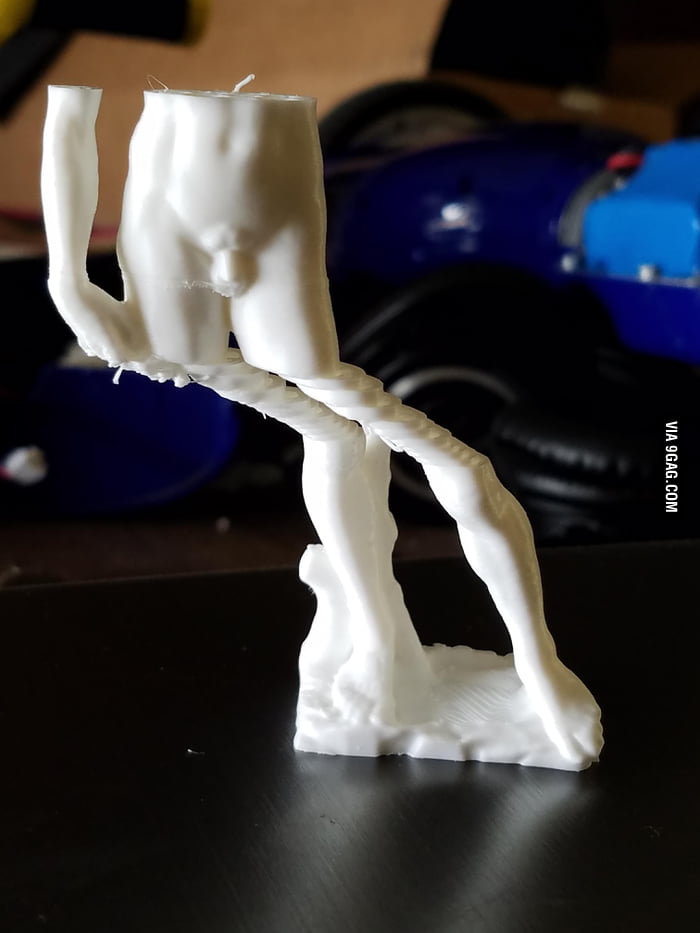 Thus, it is important to use filaments in the correct way. It should be wound properly onto the spool. It is also crucial to set the temperature of the heated platform correctly.
Thus, it is important to use filaments in the correct way. It should be wound properly onto the spool. It is also crucial to set the temperature of the heated platform correctly.
- Support
To ensure the quality of the 3D printed model, 3D support structures are needed. It is also used to create complex and highly detailed 3D parts.
The support structures should have the correct thickness and right distance between the object in order to get high resolution on 3D parts.
- 3D printing speed
The 3D printer speed can have a significant impact on the final 3D model. If the 3D printing job consumes more time, this means that it could result in better finishes on the edges and corners.
3. Things that must be consideredHere are some things to consider when it comes to 3D printing resolution.
- Curves and Acute angles
If a 3D model has more curves, then it is possible that the edges will be rough.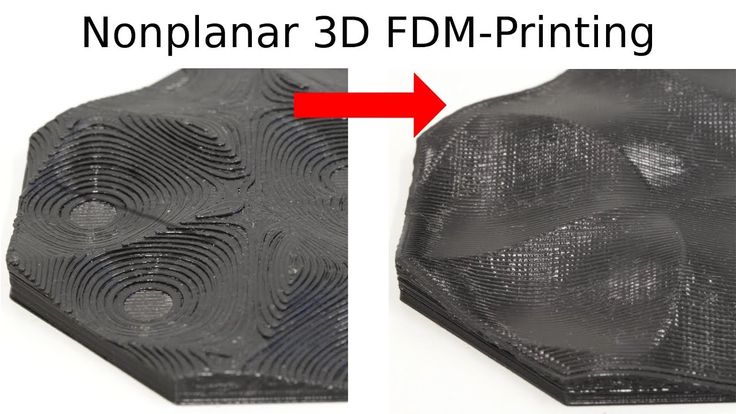 To avoid this, it is recommended to print the 3D part in thin layers. Once the 3D part is printed in thinner layers, the edges will become smoother.
To avoid this, it is recommended to print the 3D part in thin layers. Once the 3D part is printed in thinner layers, the edges will become smoother.
Resolution also relates to the thickness of the liquid (or semi-liquid) material that is ejected from the extruder of the 3d printer. This means that if the extruder produces thinner layers, the resolution of the 3D model is higher.
The same goes with acute angles. The thicker the layers, the resolution of the 3D part is lower. Hence, you must make sure that the layers are thinner to create high resolution 3D models.
- Size
For larger 3D objects, the level of resolution may not be necessary. However, for smaller and highly detailed 3D parts, high resolution is required. This is because those objects may have interlocking or connecting parts.
ConclusionBefore you start with 3D printing, it is important to consider the desired resolution for your 3D parts. Your choice will also depend on what you need for your 3D printing project.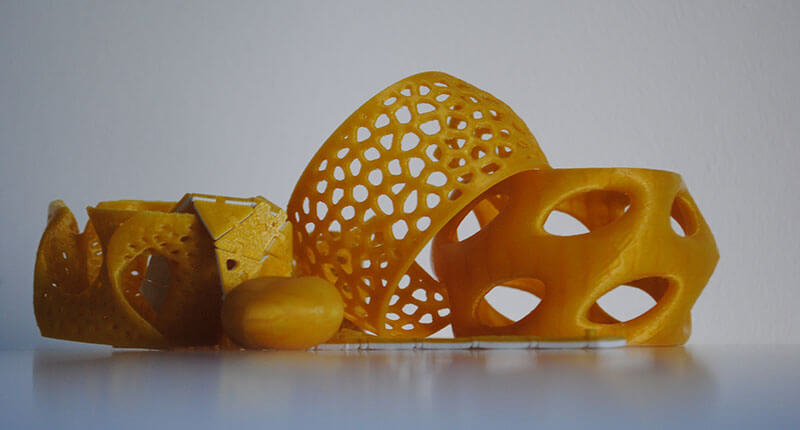
This blog post is a good start off for those who want to know more about 3D printing resolution and how it works. If you need more assistance when it comes to your 3D printing needs, do not hesitate to call a 3D printing service provider in Sydney. They also have 3D printers that are capable of printing high-resolution 3D components.
What Does Resolution Mean in 3D Printing?
Looking for a high resolution 3D printer? “Resolution” is an often discussed but seldom understood value in the world of 3D printing and additive manufacturing. How does XY and Z resolution influence on the quality of your 3D prints? What's minimum feature size and what layer thickness should you choose?
In this comprehensive guide, you'll learn how 3D printer resolution affects your 3D prints and how it differs between SLA, FDM, and DLP 3D printers.
Technology has been in a resolution war for decades. Televisions recently quadrupled pixel counts from HD to 4K and are poised to do it again soon to 8K.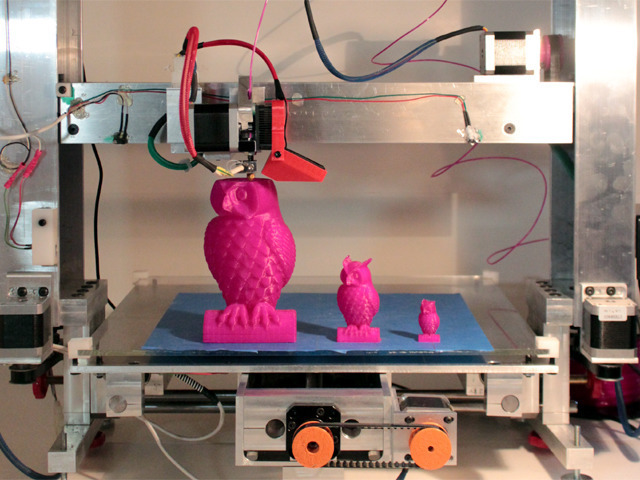 Cell phones, tablets, and anything with a screen will have its resolution as the lead on the spec sheet, provided that it’s something to boast about. But this is nothing new. Resolution wars have been waged since digital technology became popular, and the printing industry was one of the first battlegrounds.
Cell phones, tablets, and anything with a screen will have its resolution as the lead on the spec sheet, provided that it’s something to boast about. But this is nothing new. Resolution wars have been waged since digital technology became popular, and the printing industry was one of the first battlegrounds.
If you were around in the 80’s and 90’s, you remember Canon, Brother, HP, Epson, and Lexmark (among others) battling it out for print speed and resolution. What started at 100x100 dots per inch (DPI) quickly escalated to 300x300, then 600x600, and finally the current industry standard of 1200x1200 DPI. Back then, the meaning of these values was clearly understandable; even the units made perfect sense. Unfortunately, things get more complicated when you add another dimension to printing.
A print’s level of detail is impacted by the 3D printer's resolution in all three dimensions.
In 3D printing and additive manufacturing, there are three dimensions to consider: the two planar 2D dimensions (X and Y) and the Z dimension that makes it 3D printing.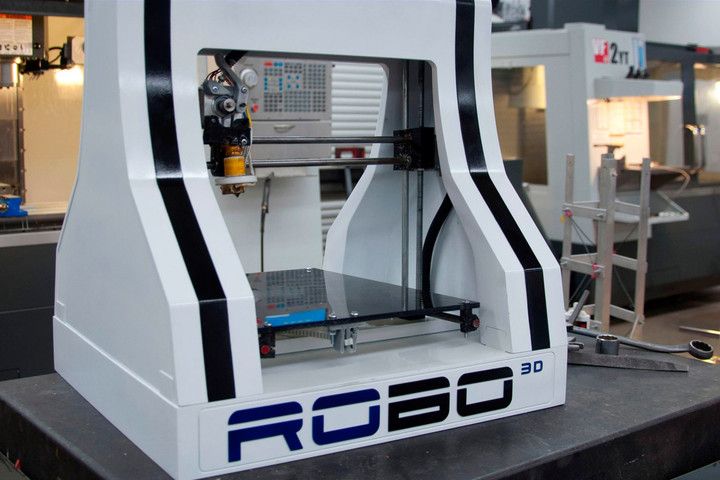 Since the planar and Z dimensions are generally controlled via very different mechanisms, their resolutions are going to be different and need to be treated separately. As a result, there is a lot of confusion about what the term “3D printing resolution” means and what level of print quality to expect.
Since the planar and Z dimensions are generally controlled via very different mechanisms, their resolutions are going to be different and need to be treated separately. As a result, there is a lot of confusion about what the term “3D printing resolution” means and what level of print quality to expect.
Sample part
See and feel Formlabs quality firsthand. We’ll ship a free sample part to your office.
Request a Free Sample Part
Formlabs' high resolution SLA 3D printers have high Z-axis resolution and a low minimum feature size on the XY plane, allowing them to produce fine details
What makes a 3D printer high resolution? There’s not a one-number answer. Since 3D printers produce parts in 3 dimensions, you will have to consider at least two numbers: the minimum feature size of the XY plane and the Z-axis resolution (layer thickness or layer height). The Z-axis resolution is easily determined and therefore widely reported even though it is less related to print quality and surface finish. The more important XY resolution (minimum feature size) is measured via microscopic imaging and is therefore not always found in spec sheets.
The more important XY resolution (minimum feature size) is measured via microscopic imaging and is therefore not always found in spec sheets.
Practically, it means that you should pick a 3D printer that performs well in both categories (in all 3 dimensions).
White Paper
Looking for a 3D printer to realize your 3D models in high resolution? Download our white paper to learn how SLA printing works and why it's the most popular 3D printing process for creating models wth increadible details.
Download the White Paper
White Paper
Download this report for an internal test that Formlabs created to determine the dimensional accuracy of the Form 3 and Form 3B.
Download the White Paper
A lot has changed since the first desktop 3D printers became available to the public. Now stereolithography (SLA) 3D printers, like the Form 3+, are competing for the same desktop spots as fused deposition modeling (FDM) 3D printers. One of the main advantages that resin-based SLA 3D printers hold over their plastic-melting cousins is print quality: SLA 3D printers produce significantly smoother and more detailed prints. While SLA printers can usually also achieve significantly smaller layer thicknesses, the reason for the improved print quality lies in their much higher XY-resolution.
One of the main advantages that resin-based SLA 3D printers hold over their plastic-melting cousins is print quality: SLA 3D printers produce significantly smoother and more detailed prints. While SLA printers can usually also achieve significantly smaller layer thicknesses, the reason for the improved print quality lies in their much higher XY-resolution.
SLA 3D printers (right) offer higher resolution and can produce significantly smoother and more detailed prints than FDM 3D printer (left).
Unlike on FDM 3D printers, minimum feature size in the XY plane on SLA 3D printers is not limited by molten plastic flow dynamics but rather optics and radical polymerization kinetics. While the math is complicated (and outside the scope of this post), it shakes out to this: features on SLA prints can be approximately as small as the diameter of their laser spots. And laser spots can be really small, especially compared to the nozzle size of FDM printers' extruders.
Read our in-depth guide about FDM vs. SLA 3D printers to learn how they compare in terms of print quality, materials, applications, workflow, speed, costs, and more.
SLA 3D printers to learn how they compare in terms of print quality, materials, applications, workflow, speed, costs, and more.
Resin 3D printers like SLA, LFS and DLP technologies offer the highest resolutions of all 3D printing processes available on the desktop. The basic units of the these processes are different shapes, making it difficult to compare the different machines by numerical specifications alone.
DLP 3D printers have a fixed matrix of pixels relative to the build area, while laser-based SLA and LFS 3D printers can focus the laser beam on any XY coordinate. This means that laser-based machines, given high-quality optics, can more accurately reproduce the surface of a part even if the laser spot size is larger than the DLP pixel size.
Whichever resin 3D printing process you choose, however, professional resin 3D printers should be able to capture the finest details of your creations, from photorealistic models to intricate jewelry.
In SLA and LFS 3D printing (left), layer lines are close to invisible.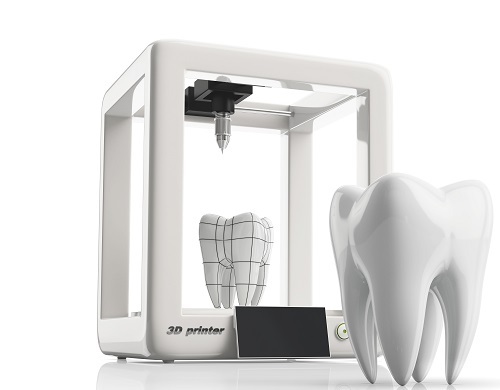 As a result, surface roughness is reduced, which ultimately leads to smooth surfaces, and for clear materials, more translucent parts. DLP 3D printers render images using rectangular voxels, which causes an effect of vertical voxel lines (right).
As a result, surface roughness is reduced, which ultimately leads to smooth surfaces, and for clear materials, more translucent parts. DLP 3D printers render images using rectangular voxels, which causes an effect of vertical voxel lines (right).
Learn more about the differences between SLA and DLP 3D printers and see how they compare in terms of resolution, accuracy, precision, build volume, surface finish, speed, and workflow.
In the world of 3D printing, no factor influences print quality more than XY resolution. Often discussed but seldom understood, the definition of XY resolution (also called horizontal resolution) varies by 3D printing technology:
- SLA and LFS 3D printers: a combination of the laser’s spot size and the increments by which the laser beam can be controlled
- DLP 3D printers: the pixel size, the smallest feature the projector can reproduce within a single layer
- FDM 3D printers: the smallest movement the extruder can make within a single layer
As a rule of thumb, the lower the number, the better the details. Yet this number is not always included in spec sheets, and when it is, the published value is not always accurate. To truly know a printer’s XY resolution, it’s important to understand the science behind the number.
Yet this number is not always included in spec sheets, and when it is, the published value is not always accurate. To truly know a printer’s XY resolution, it’s important to understand the science behind the number.
Practically, how does XY resolution affect your 3D prints? In order to find out, we decided to test the Form 2 SLA 3D printer. The Form 2 has a laser spot size of 140 microns (FWHM), which should allow it to print fine details on the XY plane. We put it to the test to see if this ideal resolution holds true.
To test the Form 2’s minimum feature size on the XY plane, we designed a model (left) with lines ranging from 10 to 200 microns and printed it in Clear Resin (right).
First, we designed and printed a model to test the minimum feature size on the XY plane. The model is a rectangular block with lines of varying widths in horizontal, vertical, and diagonal directions to avoid directional bias. The line widths range from 10 to 200 microns in 10 micron steps and are 200 microns tall, which equates to two layers when printed at 100-micron Z resolution. The model was printed in Clear Resin, washed twice in an IPA bath, and post-cured for 30 minutes.
The model was printed in Clear Resin, washed twice in an IPA bath, and post-cured for 30 minutes.
The model was photographed and tinted green to improve visibility. On the right side of the window, the vertical yellow line with black points measures the width of a photographed line.
After post-curing, we put the model under a microscope and took high-resolution photos for analysis. Using ImageJ, the NIH’s free image analysis software, we first scaled the pixels of the images and then measured the actual widths of the lines printed. We collected over 50 data points per line width to eliminate measuring errors and variability. In total, we printed and analyzed three models on two different printers.
The results indicate that the Form 2 has the same ideal and actual XY resolution for features that are 150 microns and larger.
As the print’s line width decreases from 200 to 150 microns, the ideal values are within the 95% confidence interval of the measured value. As the intended line widths get smaller than 150 microns, the measured interval starts to deviate significantly from the ideal. This means that the printer can reliably produce XY features as small as 150 microns, about the size of a human hair.
As the intended line widths get smaller than 150 microns, the measured interval starts to deviate significantly from the ideal. This means that the printer can reliably produce XY features as small as 150 microns, about the size of a human hair.
The Form 2’s minimum feature size on the XY plane is about 150 microns—only 10 microns larger than its 140-micron laser. The minimum feature size can never be smaller than the laser spot size, and there are many factors that affect this value: laser refraction, microscopic contaminants, resin chemistry, and much more. Considering the printer’s entire ecosystem, a 10-micron difference is nominal. Not every 3D printer’s published resolution holds true, so it’s a good idea to do plenty of research before choosing the one that's right for your project.
If your work calls for prints with intricate details, look for a printer with an XY resolution that’s backed by measurable data, not just a number.
When you read 3D printer spec sheets, you’ll see one value show up more than any else: Z resolution. Also known as layer thickness or layer height, the vertical resolution was the first major numerical differentiation between early 3D printers. Early machines struggled to break the 1 mm barrier, but now layer thicknesses on FDM 3D printers can be sub-0.1 mm thin, while LFS and SLA 3D printers are even more precise.
Also known as layer thickness or layer height, the vertical resolution was the first major numerical differentiation between early 3D printers. Early machines struggled to break the 1 mm barrier, but now layer thicknesses on FDM 3D printers can be sub-0.1 mm thin, while LFS and SLA 3D printers are even more precise.
Formlabs 3D printers support layer thicknesses between 25 to 300 microns, depending on the material. This selection of layer heights gives you the ideal balance of speed and resolution. The main question is: what is the best layer thickness for your print?
High resolution 3D printing comes with a tradeoff. Thinner layers mean more repetitions, which in turn means longer times: printing at 25 microns vs. 100 usually increases the print time four-fold. More repetitions also mean more opportunities for something to go wrong. For example, even at a 99.99% success rate per layer, quadrupling the resolution lowers the chance of print success from 90% to 67% if one assumes that a failed layer causes total print failure.
Lower layer thickness equals more time, artifacts, and errors.
Does higher resolution (thinner layers) result in better prints? Not always—it depends on the model to be printed and the 3D printer’s XY resolution. In general, thinner layers equals more time, artifacts, and errors. In some cases, printing models at lower resolutions (i.e. thicker layers) can actually result in higher-quality prints.
Thinner layers are typically associated with smoother transitions on diagonals, which leads many users to generalize and push Z resolution to the limits. But what if the model consists mostly of vertical and horizontal edges, with 90-degree angles and few diagonals? In those cases, additional layers don’t improve the quality of the model.
The issue is compounded if the XY resolution of the printer in question is not perfect and “colors outside the lines” when drawing the outside edges. More layers means more mismatched ridges on the surface. While the Z resolution is higher, the model will look like it is significantly lower quality in this case.
That being said, there are times when you want higher resolution. Given a printer with good XY resolution and a model with intricate features and many diagonal edges, dialing down the thickness of the layers will yield a much better model. In addition, if that model is short (200 or fewer layers) upping the Z-axis resolution can really improve the quality.
Certain designs benefit from a higher Z resolution: organic forms, rounded arches, small embossings, and intricate engravings.
Intricate models with elaborate details call for a higher Z resolution. SLA 3D printed parts have sharp edges, sleek surfaces, and minimal visible layer lines. This example part was printed on the Formlabs Form 3 desktop SLA 3D printer.
As a general guideline, err on the side of thicker layers and only bump up the Z resolution when completely necessary. With the right printer and a certain type of model, higher Z resolution will capture the intricate details of your design.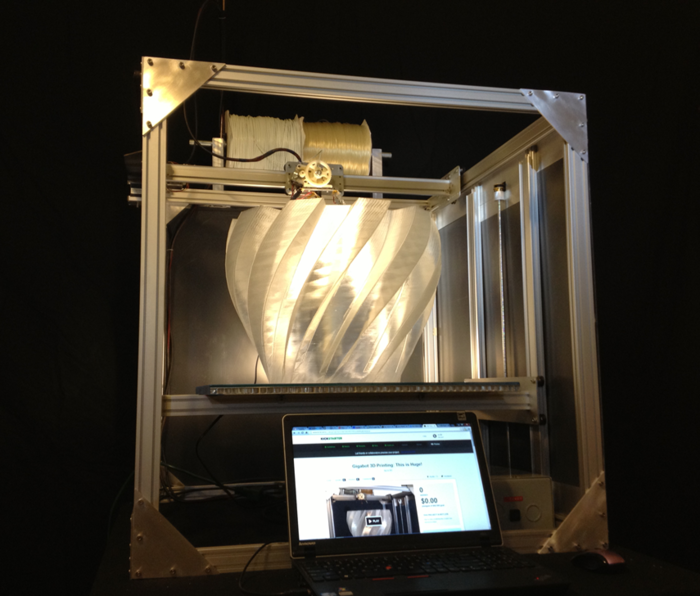
Draft Resin, the fastest 3D printing resin available for a Formlabs SLA printers, prints at 200 microns and 100 microns, while retaining the a smooth surface finish.
In PreForm, Formlabs provides users with the choice of different layer thicknesses. Depending on the material and the requirements of the application, parts can be printed in the following layer heights: 200, 160, 100, 50, and 25 microns.
The desktop Form 3+ and the large format Form 3L SLA printers are ideal for high resolution 3D printing.
After learning about 3D printing resolution and sorting out the differences in technology and outcomes, we hope it’s much easier to select 3D printer that best matches your workflow and output needs.
To explore the next generation of SLA 3D printing, learn more about the Form 3 and Form 3L LFS 3D printers.
Curious to see the what high resolution 3D printing looks like firsthand? Order a sample part shipped to your office.
Request a Free Sample Part
What is the resolution of a 3D printer? What does it affect.
 How to setup!.
How to setup!. In many technical descriptions, one can come across such a characteristic of a 3D printer as resolution. This parameter is changeable and therefore it is also important to understand what it is and what values it can take, since this will be reflected in the print results.
An analogy can be made with an ordinary image, that is, a picture. The higher the resolution, the better the picture will be, the higher the detail. However, the size of such an image will be larger. This is natural for any devices (phones, tablets, TV screens, etc.). It's the same with a 3D printer.
Any 3D model is formed by slicing. This is the process of cutting into separate horizontal layers, from which a physical model is formed.
The 3D printer has two types of resolutions:
• along the X and Y axes;
• Z-axis.
The first will be the resolution in the 3D plane, and the second will be the height of the layer.
In the specifications of a 3D printer, the maximum resolution is the minimum layer height value. The lower the layer height, the better the detail will be. At the same time, the number of layers will also increase, which will affect the printing time - it will increase.
The lower the layer height, the better the detail will be. At the same time, the number of layers will also increase, which will affect the printing time - it will increase.
For comparison, we can take FDM, SLA printers. Printing technologies are different, as are the characteristics. For an FDM printer, the minimum layer height is 0.05mm. An indicator less does not make sense, since these devices are not suitable for printing highly detailed products, as well as small models. And a smaller value of resolution along the Z axis will not affect the print quality. In SLA 3D printers, the layer thickness can be 0.005mm. Therefore, such devices are used to print small parts, such as jewelry, dental products.
A legitimate question arises: “Is high resolution always required?” If you set the layer thickness to the minimum value, then the print time will always increase. For example, if you print a product not at 100 microns, but at 25 microns of layer height, then the printing time will increase by 4 times, that is, in direct proportion.
If your model is a flat wall at a right angle, the resolution increase will not affect the quality. At least substantially accurate. In the event that your 3D printer is not well calibrated, then the layers may shift relative to each other. And it turns out that the more layers there are, the greater the displacement and, accordingly, the irregularities. And as a result, at high resolution, you can get a detail of worse quality.
If you need to print miniature products with complex elements: engravings, roundness, arches, a large number of complex shapes, then high resolution will be a must, because otherwise no elements will be clearly printed, and they may simply be invisible.
Z-axis resolution will be limited by the design of the printer. For FDM devices, this will be the nozzle diameter. It is impossible to set the layer thickness greater than the nozzle diameter, since this would be impossible from a physical point of view. For SLA printers, it is also impossible to supply more than 100 microns, since the layer must be well cured by the laser.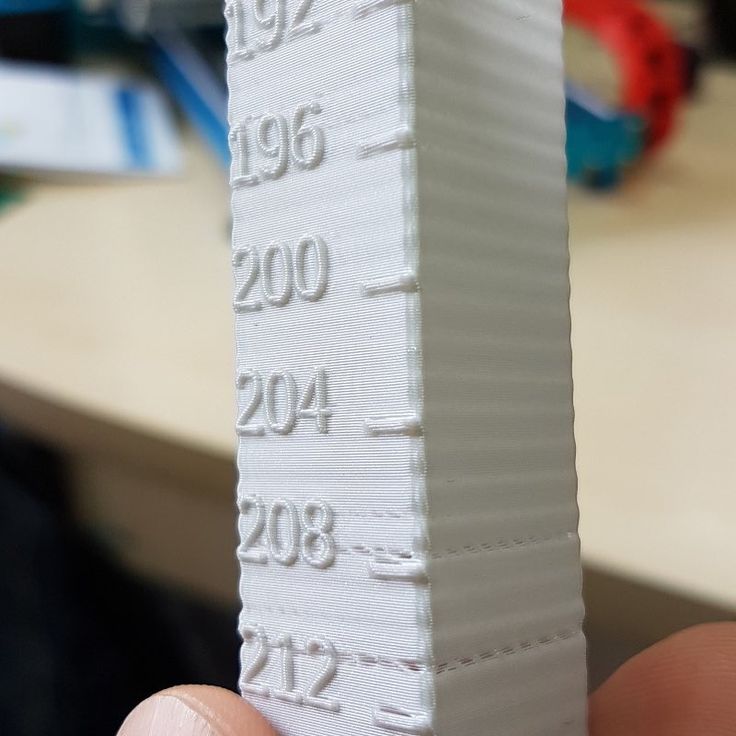 The higher the layer height, the longer it will take to illuminate the laser. In addition, due to the high layer thickness, various defects and artifacts can occur, that is, the quality of the product will suffer greatly.
The higher the layer height, the longer it will take to illuminate the laser. In addition, due to the high layer thickness, various defects and artifacts can occur, that is, the quality of the product will suffer greatly.
The X and Y resolution will depend on the design of the printer. When viewed from the point of view of prints, then this indicator will affect the last layers of the product. For an FDM printer, it will also depend on the nozzle diameter, and the smaller it is, the higher the resolution will be. In this case, the fills will be less noticeable, and the quality of the product will be higher. For SLA printers, this characteristic will be determined by the diameter of the laser spot. This value will always be constant and does not change. For DLP printers, this characteristic will depend on the pixel size and projector resolution.
What Does Resolution Mean in 3D Printing?
Looking for a high resolution 3D printer? “Resolution” is a term from the field of 3D printing and additive manufacturing that is often talked about, while rarely understanding its meaning. How does XY and Z resolution affect the quality of 3D printed models? What is the minimum element size and what layer thickness should I choose?
How does XY and Z resolution affect the quality of 3D printed models? What is the minimum element size and what layer thickness should I choose?
This detailed guide explains how 3D printer resolution affects model printing and how it differs between SLA, FDM and DLP printers.
For decades, technology manufacturers have been striving for higher resolution than their competitors. TVs have recently quadrupled their pixel count from HD to 4K, but manufacturers are already thinking about pushing the resolution to 8K. Mobile phones, tablets and other devices with screens show resolution as one of the main characteristics, if, of course, they have something to boast about. But this is nothing new. Resolution wars have been fought since the days when digital became popular and the printing industry became one of the first battlefields.
If you lived in the 80s and 90s, you'll remember how Canon, Brother, HP, Epson, and Lexmark (among others) sought to improve print speed and resolution. 100 x 100 dpi quickly grew to 300 x 300, then to 600 x 600. Finally, now the standard resolution is 1200 x 1200 dpi. Then these values were extremely clear, and the use of units of measurement was quite logical. Unfortunately, things get much more complicated when you add another dimension to print.
100 x 100 dpi quickly grew to 300 x 300, then to 600 x 600. Finally, now the standard resolution is 1200 x 1200 dpi. Then these values were extremely clear, and the use of units of measurement was quite logical. Unfortunately, things get much more complicated when you add another dimension to print.
The level of detail of the model depends on the resolution of the 3D printer in all three dimensions.
In 3D printing and additive manufacturing, there are three dimensions to consider: two planar 2D dimensions (X and Y) and a third dimension, Z, which is used for 3D printing. Since planar measurements and Z measurements are usually controlled by completely different mechanisms, their resolutions will differ. Therefore, they must be considered separately. As a result, there is a lot of confusion about the interpretation of the term "3D printing resolution" and false expectations for print quality.
Experience the quality of stereolithography for yourself. We will send a free sample of the Formlabs stereolithographic 3D printed model directly to your office.
We will send a free sample of the Formlabs stereolithographic 3D printed model directly to your office.
Request a free print sample
Formlabs high-resolution stereolithographic 3D printers feature high Z-axis resolution and a low minimum element size on the XY plane, allowing them to capture fine detail.
What affects the high resolution of a 3D printer? It is impossible to name any one isolated factor. Since 3D printers produce models in 3 dimensions, there are at least two factors to consider: the minimum size of the XY plane elements and the resolution of the Z axis (thickness or height of the layer). Z-axis resolution is easy to determine and is therefore more commonly reported, although it is less related to print and surface quality. The more important XY resolution (minimum element size) is measured with a microscope and is therefore not always found in specifications.
In practice, this means that the 3D printer must perform well in both categories (in all 3 dimensions).
White Paper
Download our White Paper to find out how SLA printing works, why thousands of professionals use it today, and how this 3D printing technology can help your work.
Download white paper
A lot has changed since the first desktop 3D printers hit the market. Now stereolithographic (SLA) 3D printers such as the Form 3 directly compete for desktop space with Fused Deposition Modeling (FDM) 3D printers. One of the main advantages of 3D printers that use polymers as consumables over their plastic-melting counterparts is print quality: SLA printers produce models with a smoother surface and a higher degree of detail. While stereolithography printers typically achieve significantly thinner layer thicknesses, the reason for the improved print quality is the much higher XY resolution.
SLA printers (right) have higher resolution and produce models with smoother surfaces and more detail than FDM printers (left).
Unlike 3D printers based on FDM technology, the minimum size of elements in the XY plane in stereolithographic 3D printers is not limited by the dynamics of the flow of molten plastic, but is more determined by the optics and kinetics of radical polymerization. Although the calculations are complex (and beyond the scope of this article), it can be said that the details on models produced by stereolithography printers are about the same size as the diameter of the corresponding laser spots. And laser spots can be very small, especially when compared to nozzles on FDM printers.
Although the calculations are complex (and beyond the scope of this article), it can be said that the details on models produced by stereolithography printers are about the same size as the diameter of the corresponding laser spots. And laser spots can be very small, especially when compared to nozzles on FDM printers.
Check out our detailed guide comparing FDM vs. SLA 3D printers to see how they differ in terms of print quality, materials, application, workflow, speed, cost, and more.
Technologies Resin-based 3D printing such as SLA, LFS and DLP provide the highest resolution of all 3D printing processes available for desktop printers. The primary units of measure for SLA and DLP processes are different forms, making it difficult to compare printers based on numbers alone.
DLP-based 3D printers have a fixed pixel matrix relative to the work area, while SLA- and LFS-printers that use a laser can focus the laser beam on any coordinate of the XY plane. This means that laser 3D printers with high optical quality can accurately reproduce the surface of the model, even if the laser spot size is larger than the pixel size in the DLP printer.
This means that laser 3D printers with high optical quality can accurately reproduce the surface of the model, even if the laser spot size is larger than the pixel size in the DLP printer.
Whichever resin 3D printing technology you choose, professional 3D printers should capture the finest details of your creations, from photorealistic models to fine jewelry.
When printing on 3D printers based on SLA and LFS technologies (left), layer lines are almost invisible. As a result, surface roughness is reduced, resulting in a smooth surface, and when using transparent materials, models with greater transparency. DLP printers use rectangular voxels to render images, which can result in vertical lines (right).
Learn more about the differences between SLA and DLP technologies in terms of resolution, accuracy, clarity, print volume, surface quality, speed, and how they work.
In the world of 3D printing, no other factor affects the quality of models more than XY resolution. She is often mentioned, but rarely understood. The definition of XY resolution (or horizontal resolution) differs depending on the 3D printing technology:
She is often mentioned, but rarely understood. The definition of XY resolution (or horizontal resolution) differs depending on the 3D printing technology:
- stereolithographic 3D printers - a combination of laser spot size and the size of the steps with which the beam can be controlled;
- DLP printers - pixel size, the smallest detail that a projector can reproduce in a single layer;
- FDM printers - the smallest distance that the extruder can move within one layer.
In general, the lower this value, the finer the detail. But this number is not always indicated in the technical specifications, and even if indicated, it is not always correct. To get an idea of true XY resolution, it is important to understand how a printer works.
How does XY resolution affect the quality of your models? To find out, we decided to test a Form 2 stereolithographic 3D printer. The size of the laser spot in the Form 2 printer is 140 µm (FWHM), which should allow it to reproduce fine details on the XY plane. We decided to check if this ideal resolution corresponds to the truth.
We decided to check if this ideal resolution corresponds to the truth.
To check the minimum feature size on the XY plane for the Form 2 printer, we designed a model (left) with lines from 10 to 200 µm thick and printed it using Clear Resin (right).
We first designed and printed the model to check the minimum element size on the XY plane. The model is a rectangular block with lines of various widths in the horizontal, vertical and diagonal directions, which are applied to prevent displacement. The line thickness is from 10 to 200 µm, the lines are drawn at 10 µm intervals and have a height of 200 µm, which corresponds to two layers when printed at a resolution of 100 µm for the Z axis. Made from Clear Resin, the model was washed twice in isopropyl alcohol and subjected to a within 30 minutes.
The model was photographed and painted green for better visibility. The vertical yellow line with black dots on the right side of the window is for measuring the width of the photographed line.
After the final polymerization, we placed the model under the microscope and took a high resolution photograph for further analysis. Using ImageJ, a free image analysis program from the National Institutes of Health (NIH), we scaled the image pixels and measured the actual width of the printed lines. We collected over 50 data points per line width to eliminate measurement errors and variability. We analyzed three models made on two printers.
The results show that the Form 2 has the same ideal and actual XY resolution for model elements as small as 150 µm.
As the line width decreases from 200 to 150 µm, the ideal values are within the 95% confidence interval of the measured value. As the expected linewidth becomes less than 150 µm, the measured interval starts to deviate significantly from the ideal. This means that the printer can reliably reproduce elements up to 150 microns in size, as thick as a human hair, on the XY plane.
The Form 2 printer has a minimum XY feature size of about 150 µm, only 10 µm larger than the 140 µm spot size of its laser. The minimum element size cannot be less than the laser spot size. There are many factors that affect this value: laser refraction, microscopic contaminants, polymer chemistry, etc. Considering the entire printer ecosystem, a difference of 10 µm is nominal. Not all 3D printers have the reported resolution equal to the actual resolution, so it's a good idea to do a lot of research before choosing the right resolution for your project.
The minimum element size cannot be less than the laser spot size. There are many factors that affect this value: laser refraction, microscopic contaminants, polymer chemistry, etc. Considering the entire printer ecosystem, a difference of 10 µm is nominal. Not all 3D printers have the reported resolution equal to the actual resolution, so it's a good idea to do a lot of research before choosing the right resolution for your project.
If you want models with fine detail, look for a printer whose XY resolution is not just listed as a number, but supported by measured data.
When looking at the specifications of 3D printers, you will find that one parameter appears more often than any other. This is the Z-axis resolution. Also known as layer thickness or layer height, vertical resolution was the first major numerical parameter by which early 3D printers were distinguished. The first such devices struggled to overcome the barrier of 1 mm, but now the layer thickness in FDM-based 3D printers can be less than 0. 1 mm, and even less in LFS and SLA printers.
1 mm, and even less in LFS and SLA printers.
Formlabs 3D printers support layer thicknesses from 25 to 300 microns, depending on the material. This range of values allows you to find the perfect balance between speed and print quality. But the main question is what layer thickness will be ideal for your model.
The high resolution of 3D printing affects other parameters. The thinner the layer, the more layers need to be printed, resulting in increased model production time: typically, printing at a resolution of 25 µm takes four times longer than printing at a resolution of 100 µm. In addition, the more layers, the higher the probability of errors. For example, even with a layer success rate of 9A 9.99% fourfold increase in resolution reduces the chances of a successful print of the model from 90% to 67%, provided that the layer with the error leads to rejects.
The thinner the layer, the longer it takes to print and the more likely it is to cause errors and distortion.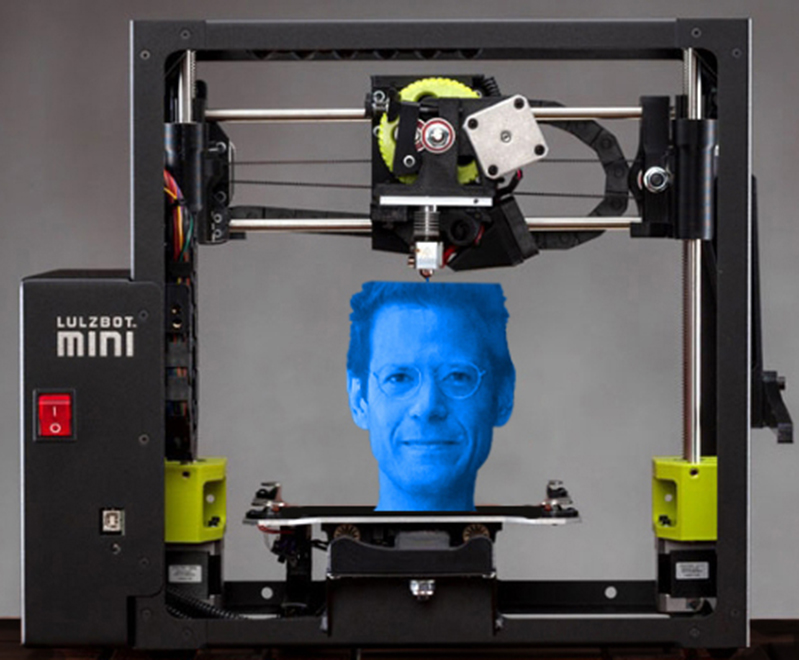
Is it true that the higher the resolution (the thinner the layers), the higher the quality of the finished models? Not always. It depends on the model and resolution of the XY 3D printer. As a general rule, the thinner the layer, the longer it takes to print and the greater the chance of distortion and errors. In some cases, printing models at a lower resolution (i.e., with thicker layers) may even result in better quality.
Thinner layers are usually associated with smoother diagonal transitions, causing many users to push Z resolution to the limit. But what if the model consists mostly of vertical and horizontal faces, with right angles and a small amount of diagonal surfaces? In such cases, increasing the number of layers will not improve print quality.
The problem is exacerbated if the printer's XY resolution is not ideal and it "goes out of bounds" when forming the outer edges. The more layers, the more mismatched protrusions will be on the surface. In this case, the finished model will look much worse, even if the Z resolution is higher.
In this case, the finished model will look much worse, even if the Z resolution is higher.
There are times when you need to increase the resolution. If you have a printer with good XY resolution and a model with complex features and many diagonal faces, reducing the thickness of the layers will allow you to get a physical model of much better quality. Also, if this model is small (no more than 200 layers), then increasing the resolution of the Z-axis will lead to a real improvement in quality.
Some designs benefit from higher Z resolution: organic shapes, rounded arches, fine embossing and intricate engraving.
A tiny model with lots of detail and arches needs a higher Z resolution. This cathedral was printed on a Form 2 printer at 25µm resolution.
Try to stick to this general rule: print thicker layers and increase the Z resolution only when it is really necessary. With the right combination of printer and model type, the higher Z resolution will capture the intricate details of your design.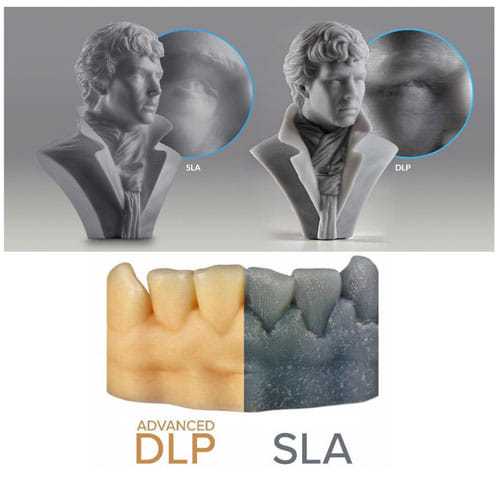
Gray Resin allows printing at a resolution of 160 microns. Check out the difference in speed for yourself.
Formlabs PreForm software allows you to select the layer thickness. As of version PreForm 3.0.3 , Gray Resin can be printed in 160, 100, 50 and 25 µm layer heights. Printing at a resolution of 160 microns will speed up the iteration process and allow engineers to move from design to finished model even faster. And dentists can make more aligners per day without sacrificing quality.
We hope that once you are familiar with the concept of resolution and understand the differences in 3D printing technologies and results, it will be much easier for you to choose a 3D printer that best suits your needs and workflow.
To learn more about the next generation of stereolithographic 3D printers, check out the Form 3 and Form 3L devices based on LFS technology.
Want to see for yourself what high-resolution prints look like? Order a print sample, which will be delivered directly to your office.






